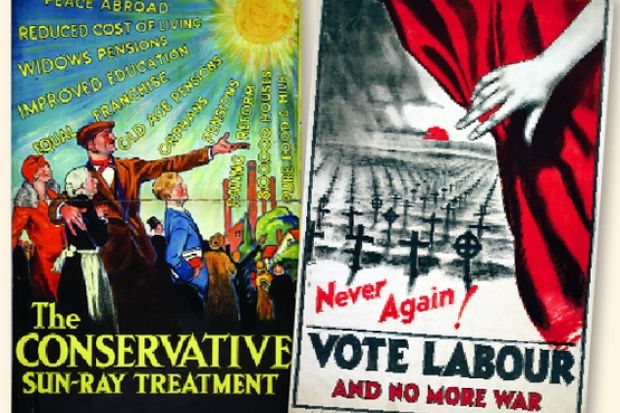Picturing Politics: Exploring the Political Poster in Britain
People's History Museum, Manchester, until 17 June 2012
For the 1929 general election, the Labour Party created a poster of a heroic worker, stripped to the waist, with the slogan "Secure Industrial Prosperity". It could almost be a piece of Soviet socialist realism. The Conservatives responded with an image that seems mildly fascist: varied representatives of the nation stand united before a sunrise representing a political version of the "Sun-ray Treatment" then used for tuberculosis.
Equally intriguing is the contrast in 1992. Labour sought votes with an image of Tony Blair, young, charming and relaxed, "because Britain deserves better". The Tories, meanwhile, warned of "New Labour New Danger", Blair's friendly smile a front for far more ominous purposes revealed by the superimposed demonic bloodshot eyes. This was anticipated in 1987 by the Labour-affiliated group of musicians, Red Wedge, who showed Mrs Thatcher like a crazed 1950s science-fiction character under the heading "There's Only One Loony Left..."
This highly entertaining exhibition - curated by Chris Burgess, a PhD student at the University of Nottingham - reminds us that posters are "a leftover of Victorian politics", although they retain their potency to this day. Around 60 examples track the story from the woefully text-heavy screeds of the 1850s to the dawn of David Cameron's Big Society. Many now seem almost unbelievably feeble. A Liberal poster from Oldham in 1900 bears the message "You Like Them: Then Vote Emmott and Runciman". Hardly more inspiring is a poster from 1935 urging us to "Vote Labour and Keep the B.B.C. Announcer Busy Saying 'Labour Gain'".
Very noticeable too is the sheer austerity of the text and artwork produced during three decades of "more photos, less drawing, fewer words" from 1950 to 1979. The most exciting appeals Labour could muster in 1955 were "Abolish the Tax on Sport" and "Top Level Talks - Send Attlee", while the Conservatives went for "Don't Swop a Record for a Promise". By 1959, however, they had come up with a famous poster, which led to accusations that they were "selling politics like soap powder", where a happy, prosperous family sit round a table, with a television in the background, because "Life's Better with the Conservatives".
The organisers are largely content to let this fascinating material speak for itself, although they do flag up a number of recurring themes.
Since posters are essentially designed for urban billboards, politicians seeking country voters had to adopt formats suitable for walls, windows and gateposts. They also had to adapt their strategies to women voters, who became part, and then an equal part, of the electorate after 1918. One can find examples of posters where they are shown as part of the workforce or threatened with unemployment. Yet the thrifty housewife's basket is seldom forgotten for long.
